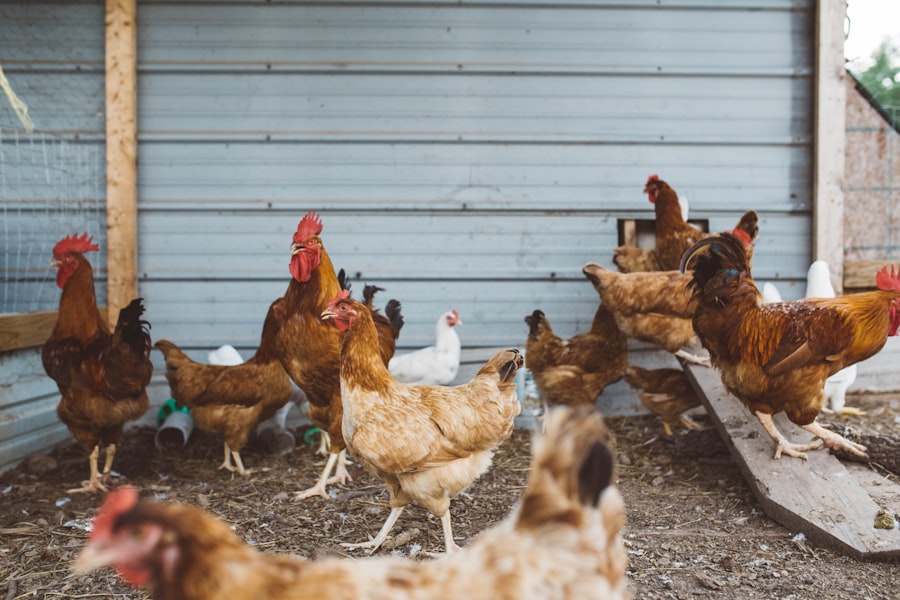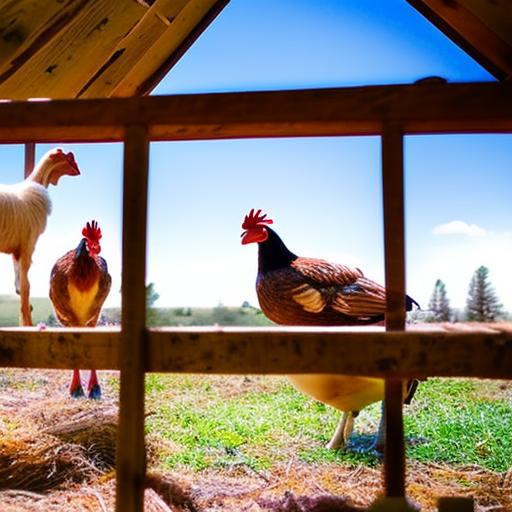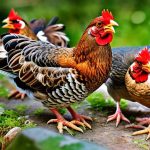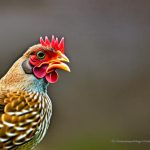Goats and chickens are two popular farm animals that are often kept together. Goats are known for their milk, meat, and fiber production, while chickens are primarily raised for their eggs and meat. Both animals have been domesticated for thousands of years and have become integral parts of many farms around the world.
One of the reasons why people keep goats and chickens together is because they can benefit from each other’s presence. Goats are natural grazers and can help control weeds and overgrown vegetation in the pasture. Chickens, on the other hand, can eat insects and pests that may bother the goats. Additionally, both animals produce manure, which can be used as fertilizer for the soil.
Key Takeaways
- Keeping goats and chickens together can have many benefits, including pest control, fertilizer production, and companionship.
- Before keeping goats and chickens together, it is important to consider factors such as space, breed compatibility, and potential health concerns.
- A suitable pen for goats and chickens should have separate areas for feeding, watering, and sleeping, as well as adequate space and protection from predators.
- Goats and chickens have different feeding requirements, so it is important to provide them with separate feeders and to monitor their diets carefully.
- Health concerns to watch out for when keeping goats and chickens together include parasites, diseases, and injuries from aggressive behavior.
- Maintaining a clean and healthy environment for goats and chickens requires regular cleaning, proper waste management, and monitoring for signs of illness or injury.
- Managing the behavior of goats and chickens in the same pen may require separating them during feeding times or providing separate areas for them to retreat to.
- Potential challenges of keeping goats and chickens together include territorial behavior, aggression, and the risk of disease transmission.
- While it is possible to keep goats and chickens in the same pen, it requires careful planning, management, and monitoring to ensure the health and safety of both animals.
Benefits of Keeping Goats and Chickens Together
1. Natural pest control: Goats and chickens have different diets, which means they can target different pests in the same area. While goats graze on grass and weeds, chickens can peck at insects and bugs. This natural pest control system can help reduce the need for chemical pesticides on the farm.
2. Mutual protection: Goats and chickens have different instincts when it comes to predators. Goats are more alert and can help protect the chickens from ground-based predators like foxes or raccoons. On the other hand, chickens have a keen sense of sight and can alert the goats to aerial predators like hawks or owls.
3. Complementary diets: Goats and chickens have different dietary needs, which means they can coexist without competing for food resources. Goats primarily eat grass, leaves, and shrubs, while chickens eat grains, seeds, insects, and kitchen scraps. This allows farmers to utilize a wider range of available feed sources on their farm.
4. Fertilizer production: Both goats and chickens produce manure that can be used as fertilizer for the soil. Goat manure is rich in nitrogen, phosphorus, and potassium, while chicken manure is high in nitrogen. When combined, these two types of manure can provide a balanced nutrient profile for the soil, promoting healthy plant growth.
Factors to Consider Before Keeping Goats and Chickens Together
Before keeping goats and chickens together, there are several factors that need to be considered:
1. Space requirements: Both goats and chickens require adequate space to roam and graze. Goats need at least 200 square feet per animal, while chickens need about 4 square feet per bird in the coop and 10 square feet per bird in the outdoor run. It’s important to ensure that there is enough space for both animals to move around comfortably.
2. Compatibility of breeds: Some goat breeds are more aggressive or territorial than others, which may not be suitable for keeping with chickens. It’s important to choose goat breeds that are known to be docile and have a calm temperament. Similarly, certain chicken breeds may be more prone to aggression or may not tolerate the presence of goats well.
3. Predators in the area: Before keeping goats and chickens together, it’s important to assess the predator situation in the area. Goats are generally more resilient against predators due to their size and strength, but chickens are more vulnerable. Adequate fencing and security measures should be in place to protect both animals from potential predators.
4. Local zoning laws: Some areas have specific regulations or zoning laws regarding the keeping of livestock or poultry. It’s important to check with local authorities to ensure that keeping goats and chickens together is allowed on your property.
Designing a Suitable Pen for Goats and Chickens
When designing a pen for goats and chickens, several considerations should be taken into account:
1. Size and layout considerations: The pen should be large enough to accommodate both goats and chickens comfortably. It should have separate areas for grazing and for the chickens to roam and scratch. The layout should allow for easy access to food, water, and shelter for both animals.
2. Fencing and security measures: The pen should be securely fenced to prevent the animals from escaping and to keep predators out. Electric fencing may be necessary to deter predators. Additionally, the chicken coop should have secure doors and windows to protect the chickens at night.
3. Shelter and nesting areas: Both goats and chickens require shelter from the elements. The goat shelter should provide adequate ventilation and protection from rain, wind, and extreme temperatures. The chicken coop should have nesting boxes for the hens to lay their eggs and roosting bars for them to perch on at night.
Feeding Requirements for Goats and Chickens in the Same Pen
While goats and chickens have different dietary needs, it is possible to feed them in the same pen with proper planning:
1. Differences in dietary needs: Goats are ruminants and require a diet high in fiber, such as grass, hay, and browse. They also need access to fresh water at all times. Chickens, on the other hand, require a diet high in protein, such as grains, seeds, insects, and kitchen scraps. It’s important to provide separate feeding areas for each animal to ensure they are getting the appropriate nutrients.
2. Feeding schedules and portions: Goats should be fed twice a day, with each feeding consisting of about 2-3% of their body weight in dry matter. Chickens can be fed once or twice a day, depending on their age and production stage. It’s important to monitor the feed intake of both animals to ensure they are not overeating or undernourished.
3. Supplemental feeding options: In addition to their natural diets, both goats and chickens can benefit from supplemental feeding options. Goats may require mineral supplements to meet their nutritional needs, while chickens may benefit from oyster shell or grit to aid in digestion. It’s important to consult with a veterinarian or nutritionist to determine the appropriate supplements for each animal.
Health Concerns to Watch Out for When Keeping Goats and Chickens Together

When keeping goats and chickens together, there are several health concerns that need to be addressed:
1. Disease transmission risks: Goats and chickens can potentially transmit diseases to each other if proper biosecurity measures are not in place. It’s important to keep the pen clean and free from feces, as some diseases can be spread through contaminated soil or water. Regular vaccinations and deworming should also be carried out to prevent the spread of diseases.
2. Parasite control measures: Both goats and chickens are susceptible to parasites such as worms, mites, and lice. Regular deworming and parasite control measures should be implemented to keep both animals healthy. It’s important to use products that are safe for both goats and chickens and to follow the recommended dosage instructions.
3. Vaccination schedules: Both goats and chickens require vaccinations to protect against common diseases. It’s important to consult with a veterinarian to determine the appropriate vaccination schedule for each animal. Vaccinations should be administered according to the recommended guidelines to ensure maximum protection.
Tips for Maintaining a Clean and Healthy Environment for Goats and Chickens
To maintain a clean and healthy environment for goats and chickens, several tips should be followed:
1. Regular cleaning and disinfecting: The pen should be cleaned regularly to remove feces, bedding, and other debris. Disinfectants can be used to kill bacteria, viruses, and parasites that may be present in the environment. It’s important to use disinfectants that are safe for both goats and chickens.
2. Proper waste management: Manure should be properly managed to prevent the buildup of harmful bacteria and parasites. It can be composted and used as fertilizer for the soil or removed from the pen and disposed of properly. It’s important to keep the manure away from areas where the animals feed or drink to prevent contamination.
3. Adequate ventilation and lighting: The pen should have adequate ventilation to prevent the buildup of ammonia and other harmful gases. Proper lighting should also be provided to ensure that the animals have a natural day-night cycle. Ventilation and lighting can help reduce the risk of respiratory diseases and promote overall health.
Managing the Behavior of Goats and Chickens in the Same Pen
When keeping goats and chickens together, it’s important to manage their behavior to prevent any conflicts or aggression:
1. Aggression and territoriality issues: Some goats may exhibit aggressive behavior towards chickens, especially if they feel threatened or territorial. It’s important to monitor their interactions closely and separate them if necessary. Providing separate feeding areas and nesting areas can help reduce competition and aggression.
2. Socialization and hierarchy dynamics: Both goats and chickens have social hierarchies within their groups. It’s important to introduce new animals gradually and allow them time to establish their place in the hierarchy. Providing enough space, food, and water can help reduce competition and promote peaceful coexistence.
3. Training and handling techniques: Goats can be trained to follow commands and respond to handling, which can help manage their behavior around chickens. Positive reinforcement techniques, such as rewards or treats, can be used to encourage desired behaviors. It’s important to handle both goats and chickens gently and calmly to avoid causing stress or injury.
Potential Challenges of Keeping Goats and Chickens Together
While keeping goats and chickens together can have many benefits, there are also potential challenges that need to be considered:
1. Noise and odor concerns: Both goats and chickens can be noisy animals, especially during breeding season or when they feel threatened. The noise and odor from the animals may be a concern for neighbors or for those living in close proximity to the farm. It’s important to consider the potential impact on the surrounding environment before keeping goats and chickens together.
2. Increased workload and expenses: Keeping goats and chickens together can increase the workload and expenses associated with their care. Both animals require regular feeding, cleaning, and health monitoring. Additionally, there may be additional costs for fencing, shelter, feed, and veterinary care. It’s important to assess the financial and time commitments before deciding to keep goats and chickens together.
3. Unforeseen health or safety issues: Despite careful planning and management, there may be unforeseen health or safety issues that arise when keeping goats and chickens together. It’s important to have a contingency plan in place and to be prepared to address any emergencies or unexpected situations that may arise.
Is It Possible to Keep Goats and Chickens in the Same Pen?
In conclusion, it is possible to keep goats and chickens together in the same pen, but it requires careful planning and management. There are many benefits to keeping these animals together, including natural pest control, mutual protection, complementary diets, and fertilizer production. However, there are also factors to consider such as space requirements, compatibility of breeds, predators in the area, and local zoning laws.
Designing a suitable pen for goats and chickens involves considering size and layout considerations, fencing and security measures, as well as providing adequate shelter and nesting areas. Feeding requirements for both animals should be taken into account, considering their different dietary needs and feeding schedules.
Health concerns such as disease transmission risks, parasite control measures, and vaccination schedules should be addressed to ensure the well-being of both goats and chickens. Maintaining a clean and healthy environment involves regular cleaning and disinfecting, proper waste management, as well as providing adequate ventilation and lighting.
Managing the behavior of goats and chickens in the same pen requires addressing aggression and territoriality issues, understanding socialization and hierarchy dynamics, as well as implementing training and handling techniques. Potential challenges such as noise and odor concerns, increased workload and expenses, as well as unforeseen health or safety issues should also be considered.
In conclusion, keeping goats and chickens together can be a rewarding experience for farmers. It allows for the utilization of natural pest control methods, promotes mutual protection, provides complementary diets, and produces valuable fertilizer. However, it is important to carefully plan and manage the pen, consider the specific needs of both animals, and be prepared to address any challenges that may arise. With proper planning and management, keeping goats and chickens together can be a successful and beneficial endeavor for any farm.
If you’re considering keeping goats and chickens in the same pen, it’s important to understand the best practices for creating a suitable living environment for both animals. To learn more about what kind of coop is best for chickens, check out this informative article from Poultry Wizard. It provides valuable insights on the ideal coop design, size, and features that ensure the comfort and safety of your feathered friends. Discover how to create a harmonious space for your goats and chickens by visiting https://poultrywizard.com/keeping-chickens/what-kind-of-coop-is-best-for-chickens/. For additional poultry-related resources, visit Poultry Wizard’s homepage at https://poultrywizard.com or explore their article on chicken coop portage at https://poultrywizard.com/keeping-chickens/chicken-coop-portage/.
FAQs
Can you keep goats and chickens in the same pen?
Yes, it is possible to keep goats and chickens in the same pen.
What are the benefits of keeping goats and chickens together?
Keeping goats and chickens together can provide mutual benefits. Goats can help control weeds and brush, while chickens can help control insects and pests. Additionally, their manure can be used as fertilizer for the pen.
What are the potential problems of keeping goats and chickens together?
One potential problem is that goats may eat chicken feed, which can lead to nutritional deficiencies for the chickens. Additionally, goats may accidentally injure or kill chickens if they become too rough during play.
What should be considered when designing a pen for goats and chickens?
The pen should be large enough to accommodate both species comfortably, with separate areas for feeding and watering. Additionally, the pen should be secure to prevent predators from entering and harming the animals.
What should be fed to goats and chickens in a shared pen?
Goats and chickens have different dietary needs, so it is important to provide separate feeders for each species. Goats require hay, grains, and minerals, while chickens require a balanced diet of grains, protein, and calcium.
Meet Walter, the feathered-friend fanatic of Florida! Nestled in the sunshine state, Walter struts through life with his feathered companions, clucking his way to happiness. With a coop that’s fancier than a five-star hotel, he’s the Don Juan of the chicken world. When he’s not teaching his hens to do the cha-cha, you’ll find him in a heated debate with his prized rooster, Sir Clucks-a-Lot. Walter’s poultry passion is no yolk; he’s the sunny-side-up guy you never knew you needed in your flock of friends!







